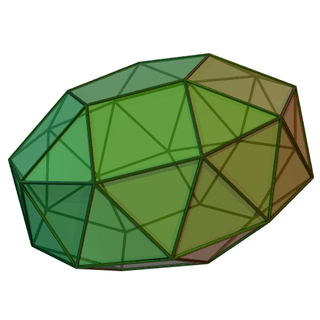Gyroelongated bicupola
|
Example pentagonal form | |
| Faces |
6n triangles 2n squares 2 n-gon |
|---|---|
| Edges | 16n |
| Vertices | 6n |
| Symmetry group | Dn, [n,2]+, (n22) |
| Rotation group | Dn, [n,2]+, (n22) |
| Properties | convex, chiral |
In geometry, the gyroelongated bicupolae are an infinite sets of polyhedra, constructed by adjoining two n-gonal cupolas to an n-gonal Antiprism. The triangular, square, and pentagonal gyroelongated bicupola are three of five Johnson solids which are chiral, meaning that they have a "left-handed" and a "right-handed" form.
Adjoining two triangular prisms to a cube also generates a polyhedron, but has adjacent parallel faces, so is not a Johnson solid. The hexagonal form is also a polygon, but has coplanar faces. Higher forms can be constructed without regular faces.
| Image cw | Image ccw | Name | Faces |
|---|---|---|---|
 |  | Gyroelongated digonal bicupola | 4 triangles, 4 squares |
 |  | Gyroelongated triangular bicupola (J44) | 6+2 triangles, 6 squares |
 |  | Gyroelongated square bicupola (J45) | 8 triangles, 8+2 squares |
 |  | Gyroelongated pentagonal bicupola (J46) | 30 triangles, 10 squares, 2 pentagon |
| Gyroelongated hexagonal bicupola | 12 triangles, 24 squares, 2 hexagon |
See also
References
- Norman W. Johnson, "Convex Solids with Regular Faces", Canadian Journal of Mathematics, 18, 1966, pages 169–200. Contains the original enumeration of the 92 solids and the conjecture that there are no others.
- Victor A. Zalgaller (1969). Convex Polyhedra with Regular Faces. Consultants Bureau. No ISBN. The first proof that there are only 92 Johnson solids.
This article is issued from Wikipedia - version of the 12/19/2013. The text is available under the Creative Commons Attribution/Share Alike but additional terms may apply for the media files.
